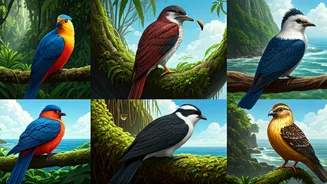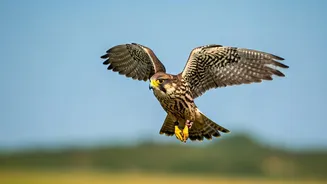The Ubiquitous Urial
First on our list is the Urial, a wild sheep known for its impressive horns. These sheep are native to Central and South Asia. Male Urials sport magnificent,
curling horns that can grow to impressive sizes. They are well-adapted to rugged, mountainous terrain, allowing them to traverse steep slopes with ease. Urials are primarily herbivores, grazing on grasses and shrubs in their natural habitat. Their survival depends on their ability to blend in with their surroundings, using their coat colors for camouflage. Conservation efforts are crucial for the Urial, as they face threats from habitat loss and hunting. They are a great example of an animal that has adapted to harsh conditions.
Unmasking the Uakari
Next, we encounter the Uakari, a primate celebrated for its distinctive appearance. Uakaris, found in the Amazon rainforest, have striking red faces and short tails. These monkeys live in groups, spending their time in the treetops. Their vibrant red faces are a sign of health, with the intensity of color often indicating their overall well-being. The Uakari's diet mainly consists of fruits and seeds. Sadly, they are vulnerable to deforestation. Maintaining their forest habitat is vital for their survival. Their physical features and social behaviors make them a fascinating species to study.
Uncovering the Uganda Kob
The Uganda Kob takes us to the African plains, where this antelope species thrives. Uganda Kobs are medium-sized antelopes with a reddish-brown coat. Males have long, curved horns which are used in mating battles and territorial disputes. They are often seen in large herds, grazing on grasses. These antelopes live in a social structure, with males defending territories. Habitat loss, caused by expanding human settlements and farming, along with hunting, pose the main threats to these animals. Efforts to protect their grasslands are crucial to help this species survive.
Understanding the Urchin
Now, we dive into the underwater world to find the sea urchin. These spiny marine animals are found in oceans worldwide. Sea urchins have a spherical body covered in protective spines. These spines are used for defense and movement. They play a vital role in marine ecosystems, eating algae and helping to maintain the health of coral reefs. Different species of sea urchins can vary significantly in size and color. Their delicate habitats are threatened by rising ocean temperatures and pollution, leading to the ongoing need for conservation efforts.
The Ubiquitous Urial
The next animal we will introduce is the Urial, a wild sheep. These sheep live in Central and South Asia. Male Urials are very distinctive because of their large horns. These horns can grow to be very impressive. They are adapted to rocky terrain and traverse mountains with ease. Urials feed on plants, and their coloration helps them hide from predators. They are another example of a species that is working to survive. Conservation efforts are important for the Urial, as they face threats from habitat loss and hunting.
Unveiling the Umbrellabird
Next, we will look at the Umbrellabird, a bird named for its unique appearance. Found in the rainforests of Central and South America, the male has a distinctive fleshy wattle that hangs from its chest, resembling an umbrella. These birds are known for their deep, resonating calls that echo through the forest. Umbrellabirds primarily feed on fruits, and their dispersal of seeds aids in maintaining a healthy forest. Deforestation, however, is a major threat to their survival. Protection of their natural environment is crucial.
The Unique Uromastyx
Our final stop brings us to the desert-dwelling Uromastyx. These lizards, also known as spiny-tailed lizards, have a robust build and a spiky tail that they use for defense. Uromastyx are found in North Africa and the Middle East. They are well-adapted to harsh desert environments and can withstand extreme temperatures. Their diet primarily consists of plants and seeds. The Uromastyx faces some threats from habitat degradation and being captured for the pet trade. Protecting their habitats and enforcing regulations are necessary to ensure the Uromastyx thrives.








